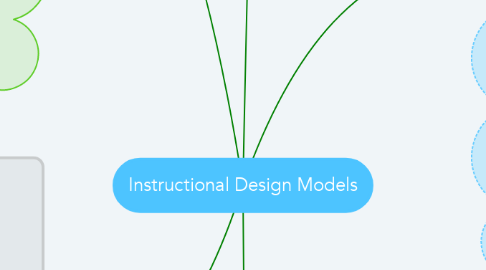
1. Gagne’s Nine Events of Instruction
1.1. Gagné published The Conditions of Learning back in 1965, which suggested that certain mental conditions must be present in order for knowledge absorption and retention to occur.
1.1.1. 1.Gain the attention of the students with a good introduction, For example, introduce a stimulus that catches and engage their brain to get the attention of the learners(novel ideas or thought-provoking question, etc.).
1.1.2. 2.Inform students of the objectives -Establish the expected outcomes and learning objectives very clearly to the learners and they should also be aware of the criteria for measuring achievement.
1.1.3. 3.Stimulate recall of prior learning -Leverage the existing knowledge of the learner before introducing new knowledge and build on it which means to make the students familiar to the new information by relating it to something they already know or something they have already experienced.
1.1.4. 4.Present the content – Deliver the content in an easily consumable chunk so that there is no information overload.
1.1.5. 5.Provide learner guidance – All the learners are not experts and might require assistance at several points. If the learners feel that they are not getting proper assistance, there can be learning disengagement.
1.1.6. 6.Elicit performance -Engage them with different activities that recall, utilize, and evaluate knowledge to elicit their performance.
1.1.7. 7.Provide feedback -Reinforce knowledge with immediate feedback (informative, remedial, corrective, etc.)
1.1.8. 8.Assess performance -Test their knowledge with established criteria. Ensure that the learners should be well aware of this assessments.
1.1.9. 9.Enhance retention and transfer to the job- Use content retention strategies to ensure that there is proper memory retention and make the learners apply it in the real working environment.
2. Merrill’s Principles of Instruction
2.1. Proposed by David Merril in 2002, this framework integrates five principles of learning, namely:
2.1.1. 1.Task-centered principle
2.1.2. 2.Activation principle
2.1.3. 3.Demonstration principle
2.1.4. 4.Application principle
2.1.5. 5.Integration principle
2.1.6. Learning starts with real-world problems. Students should be able to relate to problems and tasks they can handle.
2.1.6.1. A course must activate existing knowledge base of the learner; hence, aiding them to connect previous knowledge with the new one
2.1.6.2. A course must demonstrate the knowledge (both visually and through storytelling) hence retaining it longer in memory.
2.1.6.3. Allow them to apply new information on their own. Let them practice and learn from their mistakes. Let them see how your new material works in concrete situations.
2.1.6.4. The course must offer possibilities for integrating the knowledge into the learner’s world through discussion, reflection, and/or presentation of new knowledge.
3. ADDIE model
3.1. Analysis – Here the instructional designer should do the gap analysis and identify if the training is really required. In this stage, ID develops a clear understanding of the gap that exists between the desired outcomes and the existing knowledge and skills of the learners.
3.2. Design -In this phase, IDs select the instructional strategy to follow, write objectives, choose appropriate media and delivery methods.
3.3. Development -The output from the design phase is used here to start developing the course. The course is released/rolled-out, delivered, to the learners, and its impact is monitored.
3.4. Implementation- Once the courses are developed the next stage is the implementation of the courses on the various platforms. For example, if it’s elearning, the courses are implemented on LMS.
3.5. Evaluation -This stage involves taking the feedback on the courses like is the course providing the expected results? Feedbacks are essential to understand how effective the course was.
4. ASSURE Model
4.1. developed by Heinrich and Molenda in 1999
4.1.1. Analysis: This stage stresses on the importance of studying the audience before designing the strategy. Learners’ skills, prior knowledge, attitude, age, grade and learning style must be taken into consideration.
4.1.2. Statement of the Objectives: The objectives must be clear and sound. The Instructor must state what the learner will achieve in the end.The ID should have the clear objective of what he is trying to teach and to the learners what they are required to learn.
4.1.3. Selection of Media: Relevant media and content materials such as sound, graphics, text animations and videos must be selected for effective learning outcomes. This stage has more relevance in the eLearning industry.
4.1.4. Utilize technology, media & materials-This step in the ASSURE process concerns making a plan as to how you will utilize the technology, media, and materials that you have selected
4.1.5. Require Learners Performance: It requires to make plans to how to engage the learners in the material that you are teaching. This needs to be figured out both at the class level and the individual level.
4.1.6. Evaluate & revise-In this step, you evaluate the impact of your teaching on student learning.
4.1.6.1. 1.Did your lesson meet the learning objectives that you planned?
4.1.6.2. 2.Can this lesson be improved? How? How are you going to assess the weaknesses in your presentation?
4.1.6.3. 3.Was your choice of media and materials a good one? How will you assess the effectiveness of these tools?
4.1.6.4. 4.Is it possible that other technologies, media, and materials would have done a better job?
5. The Kemp Instructional Design model
5.1. Also known as the Morrison, Ross, and Kemp Model, this instructional design framework outlines nine circular, non-linear stages. The Kemp Design Model consists of nine steps
5.1.1. 1. Identify instructional problems and specify goals for designing an instructional program.
5.1.2. 2. Examine learner characteristics that should receive attention during planning.
5.1.3. 3. Identify subject content and analyze task components related to stated goals and purposes.
5.1.4. 4. State instructional objectives for the learner.
5.1.5. 5. Sequence content within each instructional unit for logical learning.
5.1.6. 6. Design instructional strategies so that each learner can master the objectives.
5.1.7. 7. Plan the instructional message and delivery.
5.1.8. 8. Develop evaluation instruments to assess objectives.
5.1.9. 9. Select resources to support instruction and learning activities
